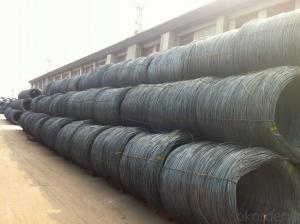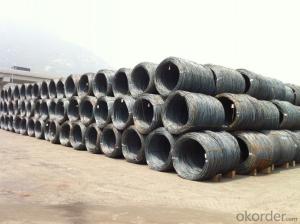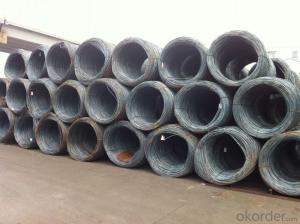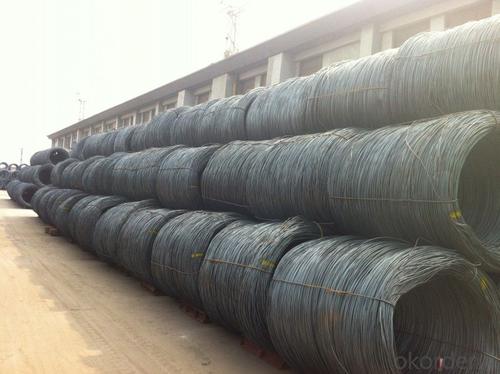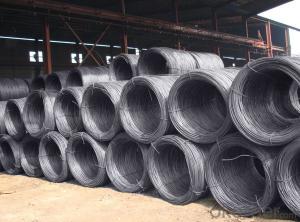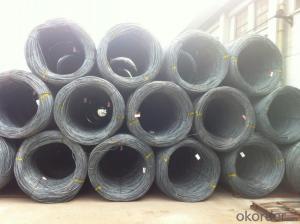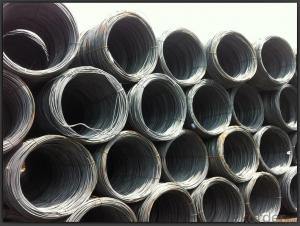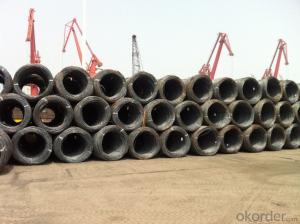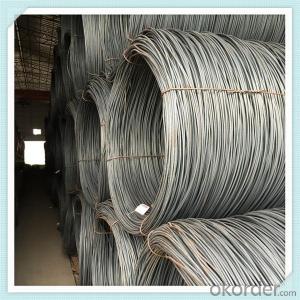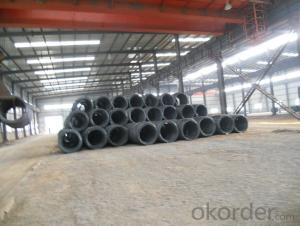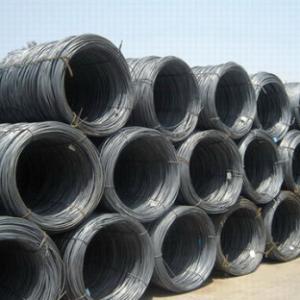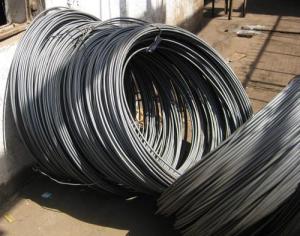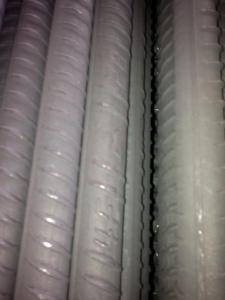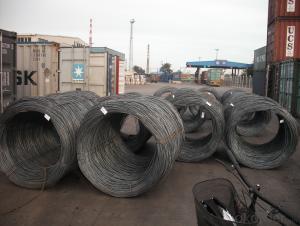SAE1008 Wire Rods Best Quality and Price and Hot Rolled
- Loading Port:
- Tianjin
- Payment Terms:
- TT OR LC
- Min Order Qty:
- 25 m.t.
- Supply Capability:
- 20000 m.t./month
OKorder Service Pledge
OKorder Financial Service
You Might Also Like
Specification
Grade: SAE1008 Standard: ASTM
Diameter: 5.5mm, 6.5mm, 7mm, 8mm, 9mm, 10mm, 11mm, 12mm
Alloy or Not: Alloy
Technique: Hot Rolled Place of Origin: China Mainland
Chemical Composition:
Please kindly find our chemistry of our material based on SAE1008 as below for your reference:
Grade | Chemical Composition (%) | |||||
C | Mn | S | P | Si | B | |
SAE1008 | 0.10max | 0.30-0.50 | 0.050max | 0.040max | 0.30max | 0.0008min |
Mechanical properties | ||||||
Yield strength(N/mm2) | Tensile strength(N/mm2) | Elongation (%) | ||||
≥195 | 350-380 | ≥32 | ||||
Usage and Applications of Wire Rod:
After hot-rolled the products shaped into coil and delivery as finished product, including round, square,rectangular, hexagonal and so on. Since most of the products are round, it is generally called wire rod. Carbon steel wire rod is widely used in construction and manufacturing. Carbon steel wire rod is mainly used for reinforcement of reinforced concrete and welded structure or reprocessed (roberts , nail, etc.) materials, especially used to produce wire drawing, welding electrode, nails, spring, electronic, precise machinery parts and so on.
Packaging & Delivery of Wire Rod:
Packaging Detail: products are packed in coil and then shipped by container or bulk vessel
Each coil weight: About 2.05MT
Delivery Detail: within 45 days after received deposit or LC.
Label: to be specified by customer, generally, each bundle has 1-2 labels
Trade terms: FOB, CFR, CIF
FAQ:
Q1: How soon can we receive the product after purchasement?
A1: Within three days of placing an order, we will begin production. The specific shipping date is dependent upon international and government factors, but is typically one month.
Q2: How do you guarantee the quality of our products?
A2: We have established an advanced quality management system which conducts strict quality tests at every step, from raw materials to the final product. At the same time, we provide extensive follow-up service assurances as required.
Q3: Why buy Materials & Equipment from OKorder.com?
A3: All products are carefully selected from China's most reliable manufacturing enterprises. Through its ISO certifications, OKorder.com adheres to the highest standards and a commitment to supply chain safety and customer satisfaction.
Images of Wire Rod
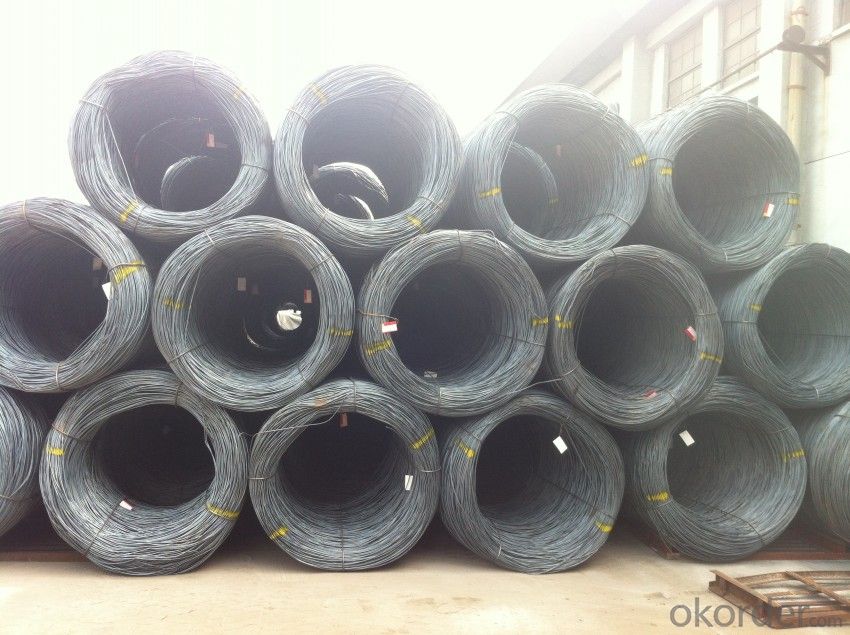
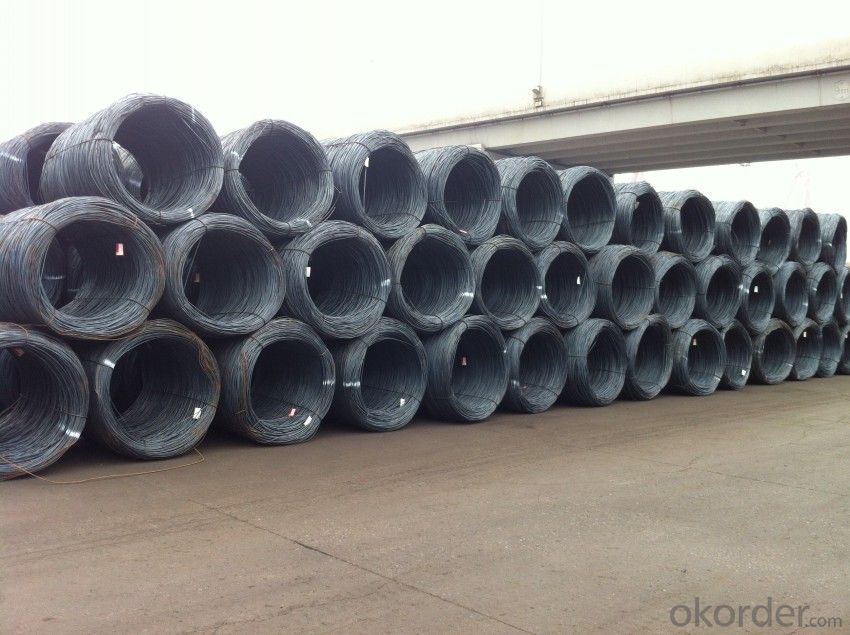
- Q: What are the different types of steel wire rod surface cleaning processes?
- Various industries commonly utilize different types of processes to clean the surface of steel wire rods. These processes aim to eliminate contaminants like rust, scale, dirt, and oil, ensuring that the wire rod is clean and ready for further use or processing. The most frequently employed steel wire rod surface cleaning processes are as follows: 1. Pickling: In this process, the wire rod is submerged in an acid solution, typically hydrochloric acid, to eradicate surface impurities. The acid reacts with the contaminants, dissolving them and leaving the wire rod clean. 2. Shot blasting: Shot blasting involves propelling abrasive particles, such as steel shots or grits, onto the wire rod's surface at high velocity. This abrasive action removes rust, scale, and other impurities, resulting in a clean and textured finish. 3. Wire brushing: Wire brushing is a mechanical process that utilizes wire brushes to scrub the wire rod's surface. This process effectively removes loose rust, dirt, and other contaminants. 4. Chemical cleaning: Chemical cleaning entails the application of specific chemical agents to the wire rod's surface. These agents react with the contaminants, breaking them down and facilitating their removal. 5. Ultrasonic cleaning: Ultrasonic cleaning employs high-frequency sound waves to generate microscopic bubbles in a cleaning solution. These bubbles implode on the wire rod's surface, creating a scrubbing action that eliminates contaminants. 6. Electrochemical cleaning: Electrochemical cleaning, also known as electrocleaning, employs an electric current to eliminate surface impurities from the wire rod. The wire rod is immersed in an electrolyte solution, and the electric current causes the contaminants to dissolve. Each of these steel wire rod surface cleaning processes possesses its own advantages and limitations. The selection of a process depends on factors such as the type and severity of contamination, the desired level of cleanliness, and the specific requirements of the application.
- Q: Can steel wire rod be used for reinforcement purposes?
- Indeed, reinforcement purposes can be fulfilled by steel wire rod. Concrete structures, such as buildings, bridges, and highways, frequently rely on steel wire rod for reinforcement. This is due to the remarkable tensile strength of steel, enabling it to endure substantial loads and stresses. When incorporated into concrete, steel wire rod effectively heightens the overall strength and longevity of the structure. Additionally, it safeguards against cracking and enhances structural integrity. Given its exceptional mechanical properties and capacity to enhance the performance of concrete structures, the construction industry commonly utilizes steel wire rod for reinforcement objectives.
- Q: What are the different types of steel wire rod surface defect prevention techniques?
- There are several techniques used to prevent surface defects in steel wire rods. These include proper cleaning and descaling of the surface, application of protective coatings, use of lubricants during the wire drawing process, and regular maintenance of the equipment to ensure smooth operation. Additionally, controlling the temperature and humidity levels in the production area can also help prevent surface defects in steel wire rods.
- Q: How is steel wire rod used in the production of wire shelves?
- Steel wire rod is used in the production of wire shelves as it serves as the raw material for making the wire mesh that forms the structure of the shelves. The wire rod is first processed and shaped into the desired wire thickness and diameter, and then it is welded or woven together to create the mesh panels that make up the shelves. This sturdy and durable material ensures the strength and stability of wire shelves, allowing them to hold and display various items efficiently.
- Q: How are steel wire rods used in the manufacturing of tire belts for vehicles?
- Tire belts for vehicles heavily rely on steel wire rods, which are indispensable components. These rods, typically crafted from high-quality steel, serve a crucial role in fortifying the strength and endurance of the tire belts. Firstly, the steel wire rods play a significant part in constructing the framework of the tire belts. They are molded into specific patterns, such as crisscross or spiral, and embedded within the rubber material during manufacturing. This reinforcement grants the tire belts the power and stability to endure the immense pressure and strain experienced during vehicle operation. Furthermore, the steel wire rods enhance the overall performance and safety of the tire belts. They preserve the shape and integrity of the belts, preventing them from distorting or collapsing under heavy loads. This aspect is especially critical for ensuring proper traction, stability, and control of the vehicle, particularly during cornering, braking, and acceleration. Additionally, the steel wire rods contribute to the tire belts' ability to resist punctures and impact damage. The robust and flexible nature of steel enables the rods to absorb and distribute external forces, minimizing the risk of tire failure due to road hazards or sudden impacts. This feature is crucial for enhancing the longevity and reliability of the tires, ultimately leading to a safer driving experience. In conclusion, steel wire rods are an essential component in the tire belt manufacturing process for vehicles. They provide reinforcement, strength, and durability to the belts, resulting in improved performance, safety, and resistance to various road conditions and external forces.
- Q: How is steel wire rod used in the production of wire for suspension bridge cables?
- The production of wire for suspension bridge cables heavily relies on steel wire rod, a crucial component. This wire rod is made from high-quality steel and is typically manufactured through the process of hot rolling. To create the wire for suspension bridge cables, the steel wire rod goes through various stages of processing. Initially, the wire rod is heated and then passed through a series of rollers, gradually reducing its size and shaping it into a continuous, long wire. This process is commonly referred to as wire drawing. The resulting wire then undergoes further processing to enhance its strength and durability. It is subjected to a heat treatment process, like annealing, which improves its mechanical properties. This treatment increases the wire's tensile strength, ensuring it can endure the immense loads and stresses experienced by suspension bridge cables. Once the wire has been appropriately treated, it is meticulously woven and braided to form the final suspension bridge cable. Multiple wires are twisted together to create strands, and several strands are then twisted together to form a larger cable. This intricate weaving process guarantees that the cable is strong, flexible, and corrosion-resistant. The use of steel wire rod in the production of suspension bridge cables is crucial because of its exceptional strength-to-weight ratio. Steel is renowned for its high tensile strength, making it ideal for supporting heavy loads over long distances. Moreover, steel wire rod offers excellent resistance to corrosion, ensuring the durability and structural integrity of suspension bridge cables. In conclusion, steel wire rod plays a vital role in producing wire for suspension bridge cables, providing the necessary strength, durability, and flexibility required for these critical infrastructure components. Its versatility and reliability make it the preferred material choice in constructing suspension bridge cables, guaranteeing the safety and functionality of these remarkable engineering marvels.
- Q: How is steel wire rod used in the production of suspension springs for automobiles?
- Steel wire rod is used in the production of suspension springs for automobiles as it provides the necessary strength and flexibility required to withstand the weight and movement of the vehicle. The wire rod is typically shaped and coiled to form the spring, which is then installed in the suspension system to absorb shocks and vibrations, ensuring a smooth and comfortable ride.
- Q: What are the different types of wire mesh for architectural use made from steel wire rod?
- Steel wire rod is used to create several different types of wire mesh for architectural purposes. These options include: 1. Welded Wire Mesh: This wire mesh is formed by welding steel wire rods at their intersection points, resulting in a grid-like pattern. It is commonly utilized for applications such as fencing, partitions, and reinforcement. 2. Woven Wire Mesh: Woven wire mesh is produced by interweaving steel wire rods in an over-and-under fashion. It is known for its strength and durability, and is often employed for architectural screening, decorative panels, and infill panels. 3. Expanded Metal Mesh: By cutting and stretching a sheet of steel wire rod, expanded metal mesh is formed, creating diamond-shaped openings. It is lightweight and provides excellent ventilation and visibility, making it suitable for architectural facades, sunscreens, and walkways. 4. Perforated Metal Mesh: This type of wire mesh is created by punching holes into a sheet of steel wire rod. It offers a variety of hole patterns and sizes, allowing for customization and versatility. Perforated metal mesh is commonly used for architectural cladding, acoustic panels, and decorative screens. 5. Architectural Mesh: Architectural mesh encompasses a range of wire mesh products specifically designed for architectural applications. It can be manufactured using various techniques such as weaving, welding, and expanded metal processes. Architectural mesh is frequently utilized for building facades, sunscreens, balustrades, and interior design elements. All of these wire mesh options, made from steel wire rod and intended for architectural use, possess unique characteristics and can be tailored to meet specific design requirements. They offer strength, durability, and versatility, making them suitable for a wide array of architectural applications.
- Q: How is steel wire rod used in the manufacturing of wire meshes?
- The production of wire meshes heavily relies on steel wire rod, which is an indispensable component. This raw material boasts remarkable durability, strength, and flexibility, making it ideal for manufacturing wire mesh products. The manufacturing procedure commences with the utilization of carbon steel or stainless steel to create the steel wire rod. Initially, the steel wire rod is subjected to a series of machines that effectively reduce its diameter while simultaneously increasing its length. This process, known as drawing, serves to augment the wire's tensile strength. Subsequently, the drawn wire is meticulously cleaned and coated to enhance its resistance to corrosion. Once the wire is prepared, it is skillfully woven or welded to construct wire meshes. The creation of woven wire mesh entails interweaving individual wires in an over-under manner, thereby forming a mesh structure. This technique permits the implementation of diverse weaving patterns, including plain weave, twill weave, or Dutch weave, resulting in a wide array of mesh openings and wire diameters to fulfill various application requirements. On the other hand, welded wire mesh is fabricated by skillfully welding the intersecting points of the steel wire, yielding a more rigid and stable mesh structure. This type of wire mesh is commonly employed in situations necessitating high strength and stability, such as construction, fencing, and reinforcement applications. The applications of wire meshes span across numerous industries. They are frequently utilized in agriculture for animal enclosures, as well as in filtration and separation processes. Additionally, wire meshes serve as concrete reinforcement, find application in automotive manufacturing, and are even employed in the aerospace industry. Wire meshes offer exceptional strength, durability, and security, all while allowing for adequate airflow, visibility, and light transmission. In conclusion, steel wire rod occupies a pivotal role in the production of wire meshes. It undergoes an assortment of processes, including drawing, cleaning, and coating, to enhance its properties. Subsequently, the wire rod is woven or welded to generate wire meshes with distinctive patterns, opening sizes, and wire diameters. Wire meshes possess exceptional qualities, enabling them to cater to a wide array of industries due to their strength, versatility, and functional properties.
- Q: What are the factors that affect the tensile strength of steel wire rod?
- There are several factors that can affect the tensile strength of steel wire rod. These include: 1. Chemical composition: The specific combination of elements in the steel, such as carbon, manganese, and silicon, can significantly impact its tensile strength. Higher carbon content generally leads to greater strength, while other alloying elements can further enhance or reduce strength depending on their properties. 2. Heat treatment: The process of heating and cooling steel wire rod can alter its microstructure and ultimately affect its tensile strength. Various heat treatment methods, such as quenching and tempering, can be employed to achieve the desired strength level. 3. Manufacturing process: The way the steel wire rod is produced and processed can also influence its tensile strength. Factors such as rolling temperature, reduction ratio, and cooling rate can affect the alignment of the steel's crystalline structure, which in turn affects its strength properties. 4. Grain size: The size of the grains in the steel wire rod can have an impact on its tensile strength. Smaller grain sizes generally lead to higher strength, as they provide more barriers for dislocations to move through the material. 5. Surface condition: The presence of surface defects, such as cracks or scratches, can act as stress concentrators and weaken the tensile strength of the steel wire rod. Therefore, proper surface treatment and handling during manufacturing and transportation are crucial in maintaining its strength. 6. Environmental conditions: The environment in which the steel wire rod is used can also affect its tensile strength. Factors such as temperature, humidity, and exposure to corrosive substances can lead to degradation or embrittlement of the material, resulting in reduced strength. Overall, the tensile strength of steel wire rod is influenced by a combination of its chemical composition, heat treatment, manufacturing process, grain size, surface condition, and environmental factors. Understanding and controlling these factors are essential in ensuring the desired strength and performance of the steel wire rod in various applications.
Send your message to us
SAE1008 Wire Rods Best Quality and Price and Hot Rolled
- Loading Port:
- Tianjin
- Payment Terms:
- TT OR LC
- Min Order Qty:
- 25 m.t.
- Supply Capability:
- 20000 m.t./month
OKorder Service Pledge
OKorder Financial Service
Similar products
Hot products
Hot Searches
Related keywords
